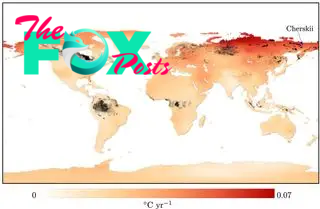Science
Arctic 'zombie fires' rising from the dead could unleash vicious cycle of warming
So-called "zombie fires" in the peatlands of Alaska, Canada and Siberia disappear from the Earth's surface and smoulder underground during the winter before coming back to life the following spring. These fires puzzle scientists because they appear in early May, way ahead of the usual fire season in the far north, and can reignite for a number of years.
Most scientists believe that zombie fires are the remnants of fires on the surface, but we have identified an alternative cause. Our research suggests that rapid atmospheric warming above ground can cause peat soils to suddenly heat up to smouldering temperatures underground, all without any spark or other ignition. These zombie fires may be a case of climate change-driven spontaneous combustion.
Reports of such fires date back to 1940s, when they were rare events. However, the frequency and intensity of these fires has increased significantly in the past two decades, hand in hand with accelerated warming in the Arctic, the fastest-warming region on the planet.
At the start of 2024, more than 100 zombie fires were active in the Canadian province of British Columbia alone. Zombie fires have even been recorded near the coldest village on earth, Oymyakon in north eastern Siberia, where they carried over through multiple winters and account for around 3.5% of area burned in the wider region each year.

More carbon is trapped in temperature-sensitive Arctic peat soils than is found in the entire atmosphere, and these fires are releasing gigatonnes of it into the atmosphere. We wanted to know if sudden warming might be directly responsible.
Two remarkable results
We developed a mathematical model to explore different what-if scenarios, including how the temperature and carbon content of peat soils respond to changes in the weather and climate. Crucially, our model captures how certain microbes generate heat while breaking down soil and releasing its carbon into the atmosphere.
We obtained two remarkable results:
-

 Science1d ago
Science1d agoInside Capitol Hill’s Latest UFO Hearings
-

 Science1d ago
Science1d agoYou Won’t Want to Miss the Leonid Meteor Shower. Here’s How and When You Can See It
-

 Science2d ago
Science2d agoHere’s What Trump’s Win Means for NASA
-

 Science5d ago
Science5d agoWhy Risky Wildfire Zones Have Been Increasing Around the World
-

 Science6d ago
Science6d agoIt’s Time to Redefine What a Megafire Is in the Climate Change Era
-

 Science1w ago
Science1w ago4 Astronauts Return to Earth After Being Delayed by Boeing’s Capsule Trouble and Hurricane Milton
-

 Science1w ago
Science1w agoThe Elegance and Awkwardness of NASA’s New Moon Suit, Designed by Axiom and Prada
-

 Science1w ago
Science1w agoSpaceX Launches Its Mega Starship Rocket. This Time, Mechanical Arms Catch It at Landing



























